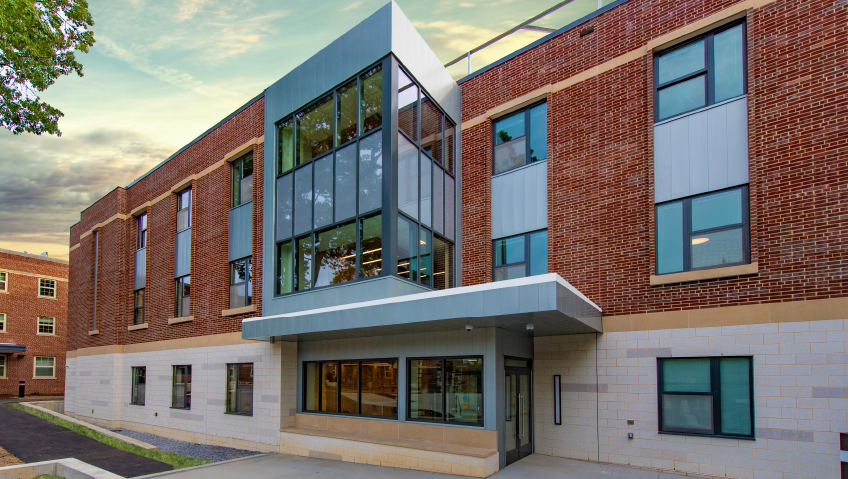If there’s an industry that learns by doing, it’s construction. No matter the theoretical background you have, from carpentry to plumbing, electrical to drywall, it’s all hands-on learning with drills, wrenches, propane torches, copper pipe, wire cutters and more.
For many of us, our early construction education was alongside a parent sawing wood, driving nails, or mixing wheelbarrows of concrete.
Others exposed to shop class in high school were taught basic skills, making wooden birdhouses, or spinning sheet metal on a lathe into ashtrays. And for those students who discovered a passion for building and working with their hands, trade schools set them on their career path.
Learning in a pandemic
One of the most popular ways to become an electrician, carpenter, plumber or learn one of the other building trades is in a classroom setting. Alongside other students under the watchful eye of a professional, men and women learn a combination of hands-on skills accompanied with textbooks to gain foundational knowledge.
Nowadays they also undergo intensive safety training according to the Occupational Safety and Health Administration in the United States (OSHA), or the Canadian Centre for Occupational Health and Safety (CCOHS), and other agencies.
Then, over a year and a half ago, an emerging Coronavirus from China changed how we live, work, and learn.
When the World Health Organization (WHO) declared SARS-CoV-2 a Public Health Emergency of International Concern on January 30, 2020, some universities, colleges and trade schools believed the virus would soon disappear, with in-class learning sure to resume a few weeks later.
That all changed when the WHO upgraded COVID-19 to pandemic status on March 11. Despite the media and government reporting that the risk to average Americans “remained low”, and National Institute of Allergy and Infectious Disease (NIAID) head Dr. Anthony Fauci saying that “people should not be walking around with masks,” everything from offices to sports stadiums to schools began closing. Openings and re-openings over the months to follow were sporadic.
While online learning through Zoom, Teams, Webex, and other platforms has proven a safe alternative to in-class face-to-face instruction, these platforms are better suited to accounting, graphic design, and business courses than to bricklaying, welding, or carpentry.
Faced with legions of paying students wanting to learn, and the need to protect those same students while adhering to ever-changing public health guidelines, some colleges and trade schools stopped in-person learning for a time.
The new norm
Others introduced what has become part of The New Norm: staggered classes with fewer students, regular health checks, mandatory mask-wearing, floors marked with directional arrows, desks and work stations spaced six feet apart, hand sanitizer, and regular disinfecting.
Construction classes worked around COVID-19 in different ways, with some reporting little impact on previous methods. Many welding classes already practiced ‘social distancing’ with booths apart from one another, with students and instructors wearing welding helmets, gloves, and other personal protective equipment (PPE) while working near exhaust fans, vital for air circulation.
Teaching some aspects of trades, like terminology, went online without issues. Other types of career and technical education (ETE) – such as servicing machinery – were not as fortunate, delaying students learning and graduation during the pandemic.
Hybrid models
Not wanting students to miss out on their education, many trade schools and colleges were compelled to shift to a hybrid approach to teaching, a combination of face-to-face and online instruction.
While e-learning is not ‘new’ – Nevada passed a charter schools law allowing development of ‘distance education’ and in-person learning back in 1997 – a combination of necessity, high-speed Internet, improved webcams, and the introduction of revolutionary, Cloud-based, videotelephony-communications technology Zoom kicked online instruction into another dimension.
Still, teaching trades is inherently an in-person activity. For many institutions, coping with COVID has proven to be challenging after millions of students worldwide stopped entering classrooms, and began spending more time online than ever before.
Depending on the region, last September saw some students returning to school. Many welcomed being back in class, while others struggled with the need to catch-up on months of lost learning.
For trade schools themselves, the challenges of balancing online learning with fewer students in buildings and safe, socially-distanced in-person education remains.
Handling burnout
To compensate, some shop teachers have created videos demonstrating tools and equipment in action, which they are sharing with their students to prevent so-called ‘Zoom fatigue’ – the cumulative result of unnaturally high eye contact online, long periods of immobility, staring at ourselves while on camera, and information overload.
Institutions worldwide are paying close attention to the impact COVID-19 is taking on education, with a recent report from the International Labour Organization and World Bank looking at the effects of the virus on learning.
Skills development in the time of COVID-19: Taking stock of the initial responses in technical education and training noted that many countries were unprepared for the virus, with instructors themselves having insufficient time to gain expertise on online teaching platforms. Among the many recommendations was: “In the immediate future, the main priority is to return to regular schooling and learning.”
This sounds ambitious, and there are undoubtedly hurdles to overcome. According to the latest information from BestColleges.com, which provides prospective students with guides, research and rankings, over 400 American colleges say students must be vaccinated against COVID-19 before returning to campus this fall.
In Canada, some institutions state that students planning to live in residence must receive their first COVID shot at least 14 days prior to moving in, and maintain records of vaccination status. It should be noted many colleges already require proof of vaccination for other highly transmissible viral diseases, including measles and mumps.
Lifting the cloud
A combination of lockdowns, enforcement of health headlines, and more of us receiving our first – if not second – vaccination is already lifting the cloud of COVID, making in-classroom learning a likelihood later this year.
And while it is likely pandemic protocols such as social distancing and wearing PPE will remain for some time, we are winning the fight. As for learning trades, colleges have invested millions of dollars into online-learning technologies. While many aspects of construction – like learning how to use a circular saw – are better learned in person, other areas can be taught online.
Considering greater access to technology, an increased familiarity and comfort with online teaching platforms, and the need for social distancing, many trade schools will maintain the hybrid model, with students returning to classrooms for the more practical, hands-on side of things, and taking instruction in technical matters online.






